Van Gogh Museum Journal 1997-1998
(1998)– [tijdschrift] Van Gogh Museum Journal–
[pagina 76]
| |
[The Collection in Context]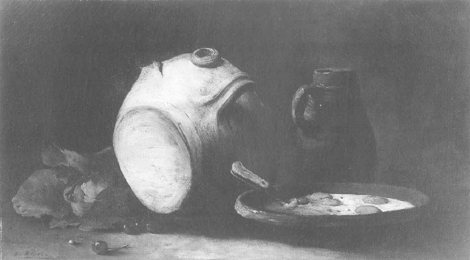 fig. 1
Théodule Ribot, Still life with eggs, Amsterdam, Van Gogh Museum | |
[pagina 77]
| |
Théodule Ribot's Still life with eggs and the practice of still-life painting in the late 19th century
| |
[pagina 78]
| |
Ribot's staunch artistic independence was already recognised during his lifetime. Indeed, in 1884 several of his closest friends and colleagues held a banquet in his honour, where they paid homage to just this aspect of his career and personality.Ga naar voetnoot5 While this fierce autonomy and refusal to belong to any artistic group or clique was quite admirable at the time, it has not served Ribot well in the century following his death. His remarkable ability to keep his personal life completely private, and to remain distant from contemporary artistic politics - to say nothing of the highly unusual nature of his paintings - have made it extremely difficult to appreciate his work or to publish a serious, comprehensive scholarly study of his life, imagery and significance.Ga naar voetnoot6 Few in 1892 could foresee how these issues would harm the artist's reputation in later years. Those who organised the retrospective did so in order to celebrate the artist's achievements and to demonstrate that his work was neither alien nor undervalued. Among those who attested to the importance of Ribot's work in 1892 were Puvis de Chavannes, who served as president of the honorary committee, as well as the writer Roger Marx, then Inspecteur des Beaux-Arts, and Arsène Alexandre, an eminent critic for Le Figaro, who were vice president and secretary, respectively. They were joined by Eugène Carrière, Albert Besnard, Henri Fantin-Latour, Norbert Goeneutte, Jean-François Raffaëlli, Henri Rouart, Antoine Vollon, Alfred Roll and Auguste Rodin, among others, in expressing reverence for their dead colleague.Ga naar voetnoot7 The fact that many of these artists also supported the recently founded Société Nationale des Beaux-Arts creates the impression that the more progressive painters of the day solidly endorsed Ribot's efforts. With such a wide range of artists involved in the show's organisation (although it should be noted that the impressionists were absent), it becomes clear that Ribot was a beloved painter whose work was both admired and collected. The extensive essay in the exhibition catalogue was written by Raoul Sertat. Its outline of the artist's life has long served as one of the primary sources of information on Ribot's career.Ga naar voetnoot8 Although the essay reveals the artist's sufferings and defines the perimeters of his work, which ranged from genre scenes of cooks to large-scale religious compositions such as the Saint Sebastian of 1865 (Paris, Musée du Louvre), its analysis was largely influenced by Sertat's personal relationship with the painter. He admired the strength of the artist's work, the power of his black paintings - whose somber sincerity became one of the defining characteristics of his oeuvre - and his ability to express human suffering in the tenaciously observed portraits of friends and family members. Sertat considered these paintings to be the work of a ‘tragic poet.’ Strangely, however, he made no mention of Ribot's interest in still life. In fact, this important category was sorely under-represented in the 1892 retrospective. This was not unusual, given the disdain with which some critics still regarded the genre. At the same time, this omission sheds light on the way the painter worked, his ties with other family members, and the position of still-life painting in the 19th century. Also confusing the issue of the place and importance of still life in the artist's oeuvre are the works of his | |
[pagina 79]
| |
children, Germain and Louise, both of whom were talented still-life painters in their own right. | |
Ribot and still-life paintingThe artist's keen interest in still life was known throughout his career, yet out of the more than 130 works on display only four such compositions appeared in the 1892 exhibition.Ga naar voetnoot9 One of the works shown was The stoneware pot (present location unknown), then in the collection of Roger Marx.Ga naar voetnoot10 A discriminating and admired collector, Marx did not hesitate to acquire works that represented a new direction or theme in an artist's output. Another exhibited still life, the Van Gogh Museum's Still life with eggs (fig. 1),Ga naar voetnoot11 then belonging to a Dutch or German collector named Steken, indicates the major interest Ribot had in this genre.Ga naar voetnoot12 Even though he did not publicly exhibit his still lifes until the mid-1860s, Ribot's concern for this theme must be seen against the background of the broader interest in still-life painting that emerged in the 1850s as part of the realist movement.Ga naar voetnoot13 Through still lifes, painters found they could emphasise visual perception and explore humble, personal themes.Ga naar voetnoot14 Some realists, including Ribot's friends François Bonvin and Antoine Vollon, sold their still lifes to collector-connoisseurs of limited means.Ga naar voetnoot15 Others eagerly produced expensive compositions filled with flowers and elegant, fashionable ceramics. Given the immense popularity of such works during the Third Republic, one critic's observation that still-life painters multiplied like rodents seems to be true.Ga naar voetnoot16 On the other hand, Ribot and other artists who scrupulously observed their surroundings had difficulty securing a clientele interested in more than depictions of pleasant objects and tasteful decor. Just as he refused to compromise in his studies of various individuals, neither did Ribot falter from his still lifes. His studies of rough earthenware ceramics, suggesting a certain sympathy towards the lower classes, or his use of objects appropriate to simple peasant meals, such as eggs in a ceramic container, were difficult to promote. Those few works that were sold went to Marx and other close friends, or to collectors with a discerning eye for structure and unusual aesthetic qualities. Despite being widely practised by many artists, still-life painting was not highly placed in the artistic pantheon. Even in the late 19th century it met with considerable resistance, being thought by members of the Académie and teachers at the Ecole des Beaux-Arts to be unimaginative and unworthy of an artist's efforts.Ga naar voetnoot17 With this attitude still lingering, compounded by the fact that few of Ribot's still lifes can be considered beautiful in any conventional sense, it is not surprising that almost none were included in the 1892 retrospective. Furthermore, it would scarcely have bolstered Ribot's reputation to have been remembered only as a painter of earthenware jugs and coarsely depicted slabs of meat. The artist kept a large number of his still lifes - a whole series was found in his studio after his death - and only his family and closest friends were ever aware of these intensely personal | |
[pagina 80]
| |
works. There are, however, still other reasons why Ribot's still lifes were a delicate issue in 1892. | |
The Veuve Ribot sale (1896)Between 1892 and the Veuve Ribot sale of May 1896, the Ribot family's financial situation deteriorated considerably. Théodule's son Clement-Théodule Ribot (known as Germain; born 1845), who was also a painter, died in Argenteuil in 1893, further complicating matters and reinforcing the belief that the Ribots were plagued by ill health and misfortune.Ga naar voetnoot18 Without Germain to carry on the family business - he had produced small pictures of cooks which were in great demand in the 1890s, and equal in popularity to similar paintings by Joseph Bail - the sole remaining artist in the family was Désirée-Marie, called Louise (1857-1916). Very little is known of her.Ga naar voetnoot19 It is clear, however, that during a large part of Ribot's later years both his son and daughter created works reflecting themes he is known to have explored himself. Indeed, Germain and Louise became accomplished still-life painters in their own right. Together, these three artists formed a kind of workshop, making it now quite difficult to discern each individual's contributions. They may also have worked in interchangeable styles, further complicating the issue of how many still lifes can actually be credited to Théodule himself. As early as 1870, and perhaps even before, Germain exhibited paintings at the annual Salon.Ga naar voetnoot20 In the Salon catalogue of that year he was listed as his father's pupil, and it was noted that his still lifes had symbolic overtones.Ga naar voetnoot21 Germain showed works at the annual exhibition throughout the 1870s. During this time his paintings were probably influenced by Antoine Vollon, whom he recorded as his teacher in 1880. Germain's still-life arrangements of vases, flowers and fruits are lighter in colour tonality than his father's. They were undoubtedly produced in the wake of the vogue for still lifes that arose in the Third Republic, and they were designed to please a middle-class clientele in search of paintings to decorate their homes.Ga naar voetnoot22 Those of Germain's paintings that have come up for sale at public auctions in recent years feature a delicate colour range and a selection of objects that are a far cry from the more sombre still lifes painted by Théodule (fig. 2). Germain remained active until his death in 1893 which, as we have seen, created a new trauma for the Ribot family. Early on, Ribot's daughter Louise also established herself as a respectable still-life painter. She exhibited at the Salons of 1877 and 1879, like her brother listing herself as her father's student. She sold one painting to the government after it had been shown at the Salon on 1884.Ga naar voetnoot23 In the early 20th century she submitted themes similar to those painted by her father, including a composition entitled Mendiants (present location unknown) that was shown at the Salon of the Société des Artistes Français in 1900.Ga naar voetnoot24 Louise participated in the Salons of 1902 and 1908 as well, although no information on the appearance of these works or later history remains.Ga naar voetnoot25 She maintained the Ribot tradition of creating still lifes for public exhibition. Such efforts not only kept the family name alive, they also brought in a steady income. With this in mind, it is now possible to turn to the Veuve Ribot sale of 1896. Out of the 76 compositions documented, 11 still lifes are noted in the catalogue of works left in Ribot's studio at the time of his death.Ga naar voetnoot26 Among them are three compositions of flowers and fruit, which must rank among the more unusual paintings attributed to the artist.Ga naar voetnoot27 | |
[pagina 81]
| |
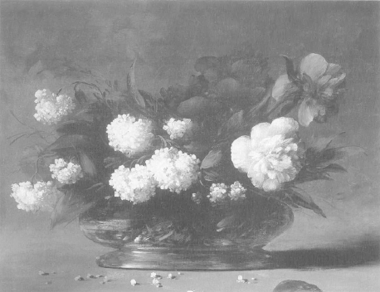 fig. 2
Germain Ribot, A vase of roses and lilacs, present location uknown (photograph courtesy of Christie's, New York) Without a specific record of their appearance, it is difficult to comment on them. The themes, however, are certainly more typical of Germain. Since the Ribot family was in financial difficulty, it is tempting to suggest that the painter's wife Marie-Clémentine (who lived until 1903), and daughter extended the body of work on offer by including paintings by other family members, particularly those by Germain. This idea is neither far-fetched nor was it a deliberate attempt to deceive the public. The Ribot family was simply carrying on a traditional practice of family studios, one that was well understood in the 19th century but rarely openly discussed. Ribot's work is marked by a variety of styles, and some of these changes may be explained by the participation of other family members - even students and paid assistants - in the production of certain canvases. It also becomes clear from the 1896 sale that still lifes had always maintained an important place in Ribot's oeuvre. The sombre tone of the work or type of coarse objects | |
[pagina 82]
| |
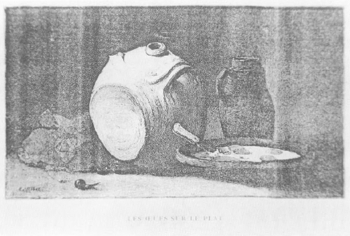 fig. 3
Engraving after Ribot's Still life with eggs, from Vente aux enchères de tableaux, études, aquarelles et dessins par Théodule Ribot, Paris (Hôtel Drouot), 30 May 1896 depicted now made little difference, as the painter simply wanted to paint what he knew intimately. He appears to have explored a limited range of themes, from fish and slabs of meat to rough ceramic containers and eggs on a platter. Each was painted in a similar format, with the scrupulously observed objects placed close to the frontal plane. From the sale, Ribot's considerable strength as a still-life painter becomes apparent through such works as the various versions of the egg meal. Other paintings, with only slight variations in the types of objects depicted or in the lighting effects, reinforce the idea that Ribot occasionally replicated an earlier successful version. One such painting is Still life with eggs (fig. 1).Ga naar voetnoot28 | |
Ribot's still lifes reconsideredThere can be little disagreement with the hypothesis that the Still life with eggs reproduced in the Veuve Ribot sale catalogue (fig. 3) has exactly the same composition as the canvas now in the Van Gogh Museum, even though the 1896 sale painting is slightly smaller in size. Somewhat perplexing, however, is that the Oeufs sur le plat shown at the 1892 retrospective, but without a description or accompanying engraving, has precisely the same dimensions as the museum's painting. This raises a number of questions. Could the owner, Steken, have given the work back to Madame Ribot for inclusion in the 1896 sale, thereby showing his compassion for the family's financial situation? Or could two versions of the subject with slightly different dimensions have been completed?Ga naar voetnoot29 Either solution seems possible, and this composition, with its theme suggesting the preparation of a simple meal, remains among Ribot's most often repeated still lifes. A third variation also existed; it was shown at the 1934 Ribot retrospective in Colombes, but has since disappeared.Ga naar voetnoot30 The Van Gogh Museum's painting confirms that Ribot was a realist, as the term was understood by critics in the 1880s.Ga naar voetnoot31 It clearly reveals his keen perception of colour in a sombre setting and with limited light, and his ability to analyse the inner structure of objects and the relationship of shapes. Critics often mentioned these qualities, and described Ribot as a ‘true realist’ who closely examined his ‘models.’Ga naar voetnoot32 The simple setting, the use of only a few objects set on a spare table, and the limited space behind these forms create spatial relationships that could be seen as extremely modern. In its emphasis | |
[pagina 83]
| |
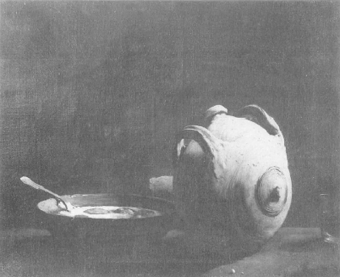 fig. 4
Théodule Ribot, Still life with eggs, Senlis, Musée de Senlis on underlying structure and observable truths, Ribot's still-life arrangement was something new at the time, as certain authors correctly perceived. Considering this unique handling, it seems surprising that a private collector (Steken, for example) would have purchased the Still life with eggs. Ribot's still lifes, with their unswerving veracity and in-depth exploration of structure, instead underscore why his works could be considered unsaleable. This ‘unsaleability’ is further reinforced by another version of the painting, now in the museum in Senlis (fig. 4).Ga naar voetnoot33 Here Ribot employed still fewer forms and an even starker arrangement, and he used a far more limited range of colours and more penetrating light to analyse the shapes. The same earthenware jug anchors the composition, while to the left lies the plate with eggs and a fork. Light enters from the right, dramatically illuminating one side of the textured jug. It touches the surface of the eggs and the rim of the ceramic vessel to draw attention to their geometric structure. Towards the outer edge is a glass of wine, while a piece of bread is hidden behind the earthenware container. The atmosphere in this work is even more solemn than in the Van Gogh Museum piece. Ribot's brooding darkness wraps these familiar objects in mystery and conveys a sense of almost religious intensity. The utter simplicity of these objects recalls the work of certain 17th-century Spanish artists, painters with whom Ribot was often associated by his contemporaries.Ga naar voetnoot34 Such comparisons, in particular with Diego Velásquez and his treatment of still lifes in ‘bodegone’ compositions, were indeed appropriate. The handling of still-life objects in the foreground of Velásquez's Water carrier of Seville (London, Wellington Museum), for example, might have inspired Ribot to play upon the coarse surface textures of | |
[pagina 84]
| |
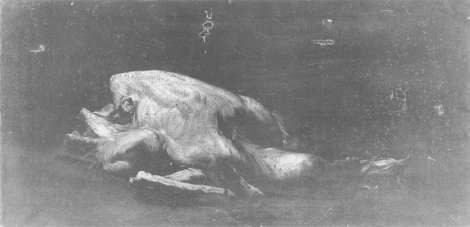 fig. 5
Théodule Ribot, A dead chicken, Paris, Musée Rodin earthenware ceramics in his own paintings. How well Ribot actually knew Spanish sources or if he ever travelled to other countries to see Spanish paintings for himself, however, remains uncertain. We also find evidence of Ribot's working methods in the Senlis painting. An earlier composition beneath the current image reveals that he painted the canvas without preliminary drawings, modifying and refining the shapes as he went along. Colour tonalities were similarly pursued, until the artist was satisfied with the results.Ga naar voetnoot35 This reuse of an earlier canvas - one with a theme that had not been fully resolved - brings up another issue: Ribot had little money to spend on canvas, and he was often forced to overpaint what he had when a composition did not turn out as imagined. Indeed, his selection of simple shapes might well reflect the misery in which he lived, which in turn reinforced the personal strength of his realism. Both the Senlis and Amsterdam versions of Still life with eggs are among his most powerful still lifes, and they permit further examination of other principles characteristic of his compositions. Beneath the Senlis painting is a study of a dead chicken, starkly positioned on a table and painted in a manner similar to the treatment of the same subject in other works. In the Musée Rodin's Dead chicken (fig. 5), for example, the flayed bird is seen in direct raking light, used to intensify the scene's veracity. This bird, much like Théodore Géricault's studies of corpses and decapitated heads, is reminiscent of an anatomy lesson. The creature's pallor, the brutally frank positioning of the neck, and the awkward way it rests on the table convey an ungainliness and directness that must have appealed to Rodin. Ribot's uncompromising | |
[pagina 85]
| |
analysis echoes Rodin's own candid and often unflattering studies of the human body. Although Rodin acquired this work for his own collection - which certainly added to Ribot's stature as a still-life painter - little is known of the relationship between the two. The fact that Ribot did studies of the sculptor does, however, suggest that a mutual understanding existed between them.Ga naar voetnoot36 In Still life with a flayed chicken (fig. 6), on the other hand, Ribot included other objects which shifted the focus somewhat away from the dead bird. Although again positioned in an inelegant way, the chicken has been joined by colourful apples, a ceramic jug and, in the foreground, oysters. These objects seem like little more than an accidental collection of various forms, carefully organised by the artist in his studio, and the spotlighting creates an almost theatrical setting. Was Ribot modifying his approach here, and if so, why? To make matters more difficult, the artist frequently neglected to date his works. It is therefore difficult to determine the precise moment in Ribot's career when this piece was completed. If a work chronology could be established, this painting would likely fall to his later years. As already noted, Ribot's son Germain often painted flowers and fruit, and he perhaps influenced his father's style. Until all the works by the various Ribot family members have been meticulously examined and ordered, however, this must remain pure speculation. Within this category of kitchen still lifes, Ribot also painted works that included a slab of meat or smaller cutlets.Ga naar voetnoot37 These images can be compared with works by François Bonvin (fig. 7), who painted on a slightly larger scale but nevertheless sought to convey the same tactile and visual qualities of the raw meat. While Bonvin's paintings were designed to look well in a dining room or were executed as part of a series for a single owner, Ribot's still lifes could never have functioned in this way. Instead, they reflect his own artistic interests, with little consideration for securing future commissions or sales. Ribot's mastery in depicting the coarseness of meat is especially notable in a picture now in the Kröller-Müller Museum (fig. 8), while the direct visual impact of the raw meat is lessened in a second composition to which eggs and kidneys have been added (fig. 9). The fact that Ribot repeated the same general arrangement several times underscores his intense exploration of the subject matter and his willingness to broaden the type of objects used in his still-life painting without, however, surrendering his brutal sense of realism. 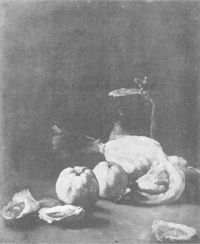 fig. 6
Théodule Ribot, Still life with a flayed chicken. Caen, Musée des Beaux-Arts de Caen 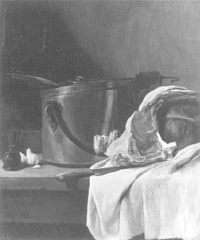 fig. 7
François Bonvin, Still life, Courtesy Wadsworth Atheneum, Hartford | |
[pagina 86]
| |
 fig. 8
Théodule Ribot, Still life with meat and two eggs, Otterloo, Kröller-Müller Museum One other still life that challenges Still life with eggs in terms of subtlety is Still life with ceramic jug and apples (fig. 10). In a very dense environment, Ribot has placed two apples, one cut in half, on a wooden support and against the backdrop of a white cloth. Completing this studio arrangement is a leather garment (most likely a cape or apron) to the left, and a rifle, seen in the dim light to the right. It remains unclear whether these objects were selected as personal items or as attributes of the hunt. Directly behind the apples, in the centre of the canvas, appears the now-familiar earthenware jug, much like the ones seen in Ribot's other works. This reliance on a well-known object brings to mind the studio practices of academic history or military painters such as Alphonse de Neuville or Ernest Meissonier, who kept garments and other accoutrements on hand for their models to wear. Ribot felt similarly comfortable with his objects: the more often he used a form, the more intimately he could discern its nature. His method of constructing his still lifes also reflects those of Bonvin and Vollon. They, too, repeatedly culled from a range of objects kept in their studios. In the Still life with ceramic jug and apples Ribot also spent more time than usual examining the shape of the apples, particularly the one cut in half. The subtle contrast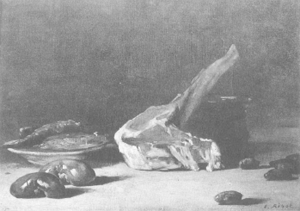 fig. 9
Théodule Ribot, Still life with meat, kidneys, and a plate of fish, Marygate, Berwick-upon-Tweed, Public Library and Museum/Art Gallery between the whiteness of the apple's core and the other grey, dimly lit shapes, indicates that the artist was moving towards another dimension of still life painting. Despite their physical presence, these forms emerge as deconstructed shapes, abstractions moving in unison to create a very modern kind of harmony. Interested in more than just the illusion of the apple, Ribot was intrigued by its structure as well. Not surprisingly, the architectural qualities of this still life - one of his most original compositions (and clearly a work that presages the work of Paul Cézanne) - were understood by the artist's friend Rodin, as it was in the sculptor's collection by 1916.Ga naar voetnoot38 Through this examination of Ribot's still life paintings it has become evident that the artist valued these works for himself. Whether or not he sold many of these canvases during his lifetime remains a matter of considerable speculation. One thing, however, is certain: still lifes allowed Ribot to fulfil his commitment to a realism akin to a ‘ruthless veracity.’ Without bowing to popular demand and burgeoning middle-class taste, Ribot created still lifes that were pure, honest, intuitive and focused on understanding the fundamental characteristics of the model, be it a coarse ceramic jug or a simple apple. The objects themselves also seem to reflect Ribot's lifestyle, a practical and | |
[pagina 87]
| |
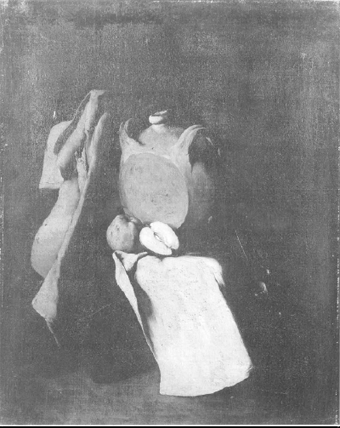 fig. 10
Théodule Ribot, Still life with ceramic jug and apples, Paris, Musée Rodin often stressful existence tinged with a love of simple pleasures. Since these qualities are also found in the best of his genre scenes and portraits, the still lifes provide an important means of assessing the artist's oeuvre as a whole. By working in this vein, Ribot could maintain his independence and originality. This endeared him to other artists, including Rodin, who were likewise striving to forge their own creative personalities outside the norm. Still-life painting remained a significant part not only of Ribot's artistic output, but also of his family's productivity and livelihood. Only by further examining works by all members of the family will it become possible to reconstruct Ribot's oeuvre accurately. For now we have established - with the help of the Still life with eggs - that Théodule Ribot was a painter of raw, visceral strength and an original artist of importance for the future. |
|

